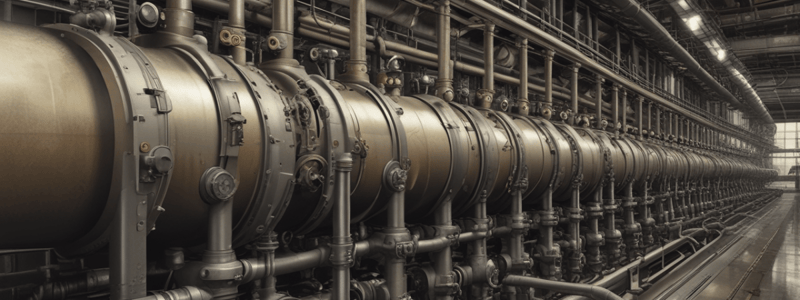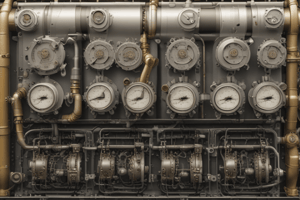Podcast
Questions and Answers
What is the main objective of the content provided?
What is the main objective of the content provided?
- To describe the different types of pressure sensors used in control loops.
- To explain the operation of pneumatic control loops.
- To provide a comprehensive guide to the design of pneumatic control systems.
- To diagnose problems with pressure loops and troubleshoot pneumatic control loops and relays. (correct)
If the pressure in the control loop is less than 200 psi, what is the likely outcome?
If the pressure in the control loop is less than 200 psi, what is the likely outcome?
- The control loop will shut down.
- The control loop will maintain the desired pressure.
- The control loop will automatically adjust to increase the pressure. (correct)
- The control loop will continue to operate but with reduced performance.
If the pressure in the control loop exceeds 200 psi, what is the likely outcome?
If the pressure in the control loop exceeds 200 psi, what is the likely outcome?
- The control loop will continue to operate with no changes.
- The control loop will shut down.
- The control loop will automatically adjust to decrease the pressure. (correct)
- The control loop will start to oscillate between high and low pressures.
What is a likely cause of a pressure loop problem?
What is a likely cause of a pressure loop problem?
What type of system is being discussed in the content?
What type of system is being discussed in the content?
What is the primary function of the control loop shown?
What is the primary function of the control loop shown?
What is the setpoint of the pressure loop?
What is the setpoint of the pressure loop?
What would happen if the pressure in the control loop exceeds 200 psi?
What would happen if the pressure in the control loop exceeds 200 psi?
What is the purpose of the relays in the control loop?
What is the purpose of the relays in the control loop?
What would be the effect on the control loop if the pressure is less than 200 psi?
What would be the effect on the control loop if the pressure is less than 200 psi?
What is a potential effect on pneumatic control if pressure fluctuates around 200 psi?
What is a potential effect on pneumatic control if pressure fluctuates around 200 psi?
What can happen if the pressure does not remain stable at 200 psi?
What can happen if the pressure does not remain stable at 200 psi?
Which condition could indicate a problem with the pressure loop?
Which condition could indicate a problem with the pressure loop?
How does the control loop respond to significant pressure drop below the setpoint?
How does the control loop respond to significant pressure drop below the setpoint?
What is an appropriate action when high-pressure conditions persist?
What is an appropriate action when high-pressure conditions persist?
What is likely to occur if the pressure drops below a critical threshold in the control loop?
What is likely to occur if the pressure drops below a critical threshold in the control loop?
How does exceeding a specific pressure level typically affect a pneumatic control loop?
How does exceeding a specific pressure level typically affect a pneumatic control loop?
What should be monitored to ensure proper functioning of the control loop?
What should be monitored to ensure proper functioning of the control loop?
Which of the following problems could arise from an unstable pressure below the designated threshold?
Which of the following problems could arise from an unstable pressure below the designated threshold?
When addressing potential issues in a pneumatic control loop, which factor is essential to consider?
When addressing potential issues in a pneumatic control loop, which factor is essential to consider?
What happens to the pneumatic control loop if the pressure is insufficient?
What happens to the pneumatic control loop if the pressure is insufficient?
Which statement indicates a problem with the pressure control loop?
Which statement indicates a problem with the pressure control loop?
If the pressure exceeds the threshold of 200 psi, what could potentially happen?
If the pressure exceeds the threshold of 200 psi, what could potentially happen?
In troubleshooting a pneumatic control loop, what is a key factor to assess?
In troubleshooting a pneumatic control loop, what is a key factor to assess?
What is a consequence of maintaining pressure below 200 psi in the control loop?
What is a consequence of maintaining pressure below 200 psi in the control loop?
What is the impact of pressure being less than 200 psi on the control loop's operation?
What is the impact of pressure being less than 200 psi on the control loop's operation?
If pressure exceeds 200 psi in the control loop, which effect is most likely?
If pressure exceeds 200 psi in the control loop, which effect is most likely?
Which scenario could indicate a malfunction in the pneumatic control loop?
Which scenario could indicate a malfunction in the pneumatic control loop?
Which action is most appropriate if pressure consistently remains above 200 psi?
Which action is most appropriate if pressure consistently remains above 200 psi?
What typically happens within a pneumatic control loop during drastic pressure drops?
What typically happens within a pneumatic control loop during drastic pressure drops?
Flashcards are hidden until you start studying
Study Notes
Diagnosing Pressure Loop Problems and Troubleshooting Pneumatic Control Loops
- Diagnosing pressure loop problems involves analyzing control loops to identify issues
- Troubleshooting pneumatic control loops and relays is a crucial aspect of process control
Control Loop Behavior
- If pressure is less than 200 psi, the control loop will behave in a certain way
- If pressure is more than 200 psi, the control loop will behave differently
Diagnosing Pressure Loop Problems and Troubleshooting Pneumatic Control Loops
- Diagnosing pressure loop problems involves analyzing control loops to identify issues
- Troubleshooting pneumatic control loops and relays is a crucial aspect of process control
Control Loop Behavior
- If pressure is less than 200 psi, the control loop will behave in a certain way
- If pressure is more than 200 psi, the control loop will behave differently
Diagnosing Pressure Loop Problems and Troubleshooting Pneumatic Control Loops
- Diagnosing pressure loop problems involves analyzing control loops to identify issues
- Troubleshooting pneumatic control loops and relays is a crucial aspect of process control
Control Loop Behavior
- If pressure is less than 200 psi, the control loop will behave in a certain way
- If pressure is more than 200 psi, the control loop will behave differently
Diagnosing Pressure Loop Problems and Troubleshooting Pneumatic Control Loops
- Diagnosing pressure loop problems involves analyzing control loops to identify issues
- Troubleshooting pneumatic control loops and relays is a crucial aspect of process control
Control Loop Behavior
- If pressure is less than 200 psi, the control loop will behave in a certain way
- If pressure is more than 200 psi, the control loop will behave differently
Diagnosing Pressure Loop Problems and Troubleshooting Pneumatic Control Loops
- Diagnosing pressure loop problems involves analyzing control loops to identify issues
- Troubleshooting pneumatic control loops and relays is a crucial aspect of process control
Control Loop Behavior
- If pressure is less than 200 psi, the control loop will behave in a certain way
- If pressure is more than 200 psi, the control loop will behave differently
Diagnosing Pressure Loop Problems and Troubleshooting Pneumatic Control Loops
- The pressure loop problem diagnosis and troubleshooting of pneumatic control loops and relays are critical concepts in process control systems.
Control Loop Scenario
-
If the pressure is less than 200 psi in the control loop: • The control loop will respond accordingly to this pressure drop. • The exact response is dependent on the specific control loop configuration and settings.
-
If the pressure is more than 200 psi in the control loop: • The control loop will respond accordingly to this pressure increase. • The exact response is dependent on the specific control loop configuration and settings.
Studying That Suits You
Use AI to generate personalized quizzes and flashcards to suit your learning preferences.




